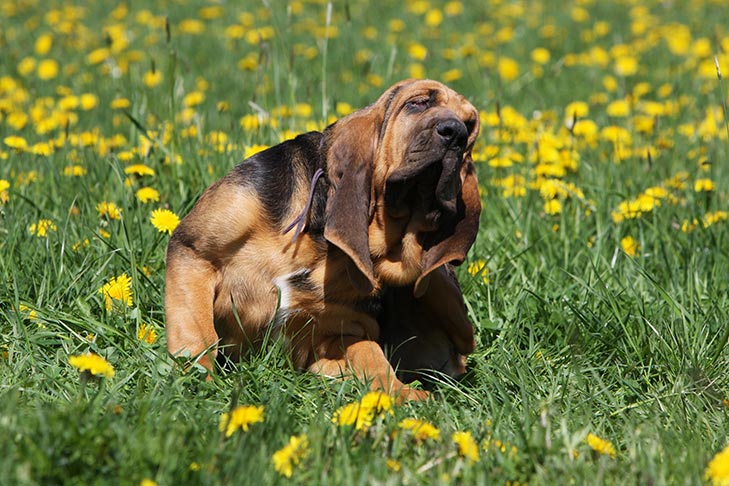Shedding happens. It’s a fact. You can always count on locks losing their grip when spring or early autumn rolls around and dogs shed their seasonal coats. Environmental factors like temperature, nutrition, and stress can also affect canine coat loss.
But while some loose hair occurs routinely during a dog’s hair growth cycles, thinning hair with mild to severe scratching and bald patches—also known as alopecia—is not. If you’re concerned your dog’s shedding is a bit excessive or abnormal, you may want to look into if they have this condition.
Canine Connection to Alopecia
Alopecia, otherwise known as abnormal hair loss or baldness, is the inability to regrow hair regularly or when hair falls out partially or entirely over the dog’s body. It occurs when the body attacks its own hair follicles, resulting in hair falling out. There’s typically a pattern to the baldness and it will either spread out or appear symmetrical. Alopecia also affects both people and dogs.
Some alopecia flareups are temporary and improve with treatment, while others are permanent. Although bald patches on the skin aren’t pretty to look at, alopecia isn’t life-threatening, and dogs can live everyday life with or without all of their hair. However, you will want to do something to make sure the itching isn’t uncomfortable for your pet.

In addition to thin areas of the coat and excessive licking, scratching, and shedding, other signs of alopecia include:
- hair loss along the dog’s side and thighs
- darkened skin or change in skin color
- dry, crusty skin
- red, inflamed skin that may appear thickened or bleeding
- dandruff or flaky skin
- red spots on the skin with or without hives or pustules (pimples).
Why Dogs Get Alopecia
When a dog scratches constantly without stopping, it causes stress and anxiety in the dog and the owner. To make matters worse, tearing at the skin to try to ease the discomfort can trauma and create wounds on your dog’s skin. To provide some relief and/or alleviate the condition, you’ll need to determine the underlying cause.
There are many reasons why a dog develops this irritating skin condition, including heredity or hormonal issues. Most are treatable or manageable. Usually, these cause the dog’s coat to thin out but don’t produce excessive itching and scratching.
A dog can acquire alopecia from a parasitic infestation of fleas, lice, mosquitoes, or mange mites such as Demodex or Sarcoptes. Spider bites or insect stings can wreak havoc on the skin, too. Plus, an inadequate diet, food allergies, or an outdoor, dirty, hot, or moist environment responsible for a fungal or bacterial infection will cause ringworm or skin allergies. You will notice that a dog will lick and scratch incessantly to relieve the irritation.
Endocrine diseases such as hypothyroidism (low thyroid hormone), Cushing’s disease (high cortisol), or reactions to rabies and corticosteroid injections can also cause alopecia. Additionally, an established yeast infection on the skin weakens the immune system and causes digestive issues, inflammation, and itching. The resulting scratching leads to hair loss.
Reactions from rabies vaccines and steroid injections, cancer, chemical exposure, burns, and normal aging can produce alopecia. While there are multiple reasons why a dog may get alopecia, you can work with your veterinarian to determine the specific cause.

Seasonal Hair Loss
Some dogs may experience seasonal flank alopecia. This non-inflammatory type of hair loss—either partial or total—usually begins in early adulthood and shows up during the cold winter months on both sides of the abdomen in front of the rear legs
Blame the shorter days and lack of sunlight for irritating the dog’s flanks. Occasionally, though, the hair loss appears on the sides of the chest, base of the tail, nose, and ears.
This type of alopecia can last six months, beginning in late fall and lasting until early spring when the hair starts to grow back.
Diagnosing Alopecia
In some cases, hair loss can signal a severe underlying condition. A trip to the veterinarian’s office will help pinpoint the problem. The vet can perform a physical examination and examine a dog’s hair follicles for signs of damage. You may also need to do blood tests or biopsies can confirm or eliminate medical causes.
Diagnostic laboratory tests with smears and a skin culture can reveal any bacterial, fungal, or yeast infections, whereas a skin scraping can rule out parasites.
Some types of alopecia are preventable, while others are not. If genetics or an auto-immune disorder is the reason for the hair loss, there’s no way to prevent it.
Ridding a dog of parasites is easier, as many preventive medicines are available. You should also reevaluate your dog’s current diet and switch to a well-balanced one or eliminating common food allergens will improve hair loss caused by an inadequate diet.
There is also a wide range of prescription medications available to treat alopecia from reoccurring. These include antibiotics, antihistamines, antifungals, and steroids. Your veterinarian will determine the best treatment for your pet.
This article is intended solely as general guidance, and does not constitute health or other professional advice. Individual situations and applicable laws vary by jurisdiction, and you are encouraged to obtain appropriate advice from qualified professionals in the applicable jurisdictions. We make no representations or warranties concerning any course of action taken by any person following or otherwise using the information offered or provided in this article, including any such information associated with and provided in connection with third-party products, and we will not be liable for any direct, indirect, consequential, special, exemplary or other damages that may result, including but not limited to economic loss, injury, illness or death.

